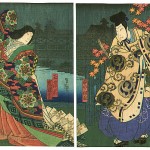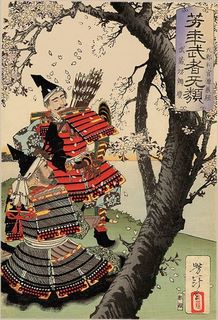Saichou traveled to China in 804 and studied the teachings of “Tiantai” Buddhism, which emphasized the importance of the Lotus Sutra, a long mystical text claimed to be the ultimate vehicle to enlightenment. (Tiantai had been introduced to Japan earlier in the form of the Ritsu school mentioned above, but that had failed to catch on.) He also studied some Esoteric teachings and some elements of Zen.
After returning to Japan in 805 he formed a friendship with Kuukai and initially the two worked closely together but apparently the two had a falling-out. According to the Shingon Buddhists, this was because Kuukai refused to give Saichou the ultimate Esoteric teachings.
Saichou had better luck winning over the leaders of the powerful Fujiwara clan who dominated the Imperial Court during the Heian period. Thanks to their patronage the Tendai sect became the largest and most influential sect in Japan.
 The Fujiwara courtiers were sophisticated and refined. Naturally they were masters of subtle and ruthless court intrigue, but they also immersed themselves in art and poetry, and they loved elaborate rituals.
The Fujiwara courtiers were sophisticated and refined. Naturally they were masters of subtle and ruthless court intrigue, but they also immersed themselves in art and poetry, and they loved elaborate rituals.
However toward the end of the Heian period the Fujiwara were challenged by upstart clans of “samurai”, hardheaded warriors from the provinces. Eventually the samurai clans were able to displace the Fujiwara as the power behind the throne. Then they began to fight with each other.
This led to a long period of instability, culminating in the absolute chaos of the Warring States period, which ended only when Ieyasu Tokugawa defeated the other samurai in 1603 and became the first Tokugawa Shogun.
 The Tendai sect played an active role in these events, fielding an army of “souhei” (warrior monks) operating out of the Enryaku-ji, a fortified temple complex on Mt. Hiei, overlooking Kyoto.
The Tendai sect played an active role in these events, fielding an army of “souhei” (warrior monks) operating out of the Enryaku-ji, a fortified temple complex on Mt. Hiei, overlooking Kyoto.
This may sound odd, but it was not unusual for the time. Other sects also employed warrior monks on a smaller scale. With various factions willing to burn down the temples of any sect thought to favor another faction it was natural for religious leaders to feel that they needed armed followers.
In 1571 the forces of Nobunaga Oda defeated the souhei and proceeded to burn down Enryaku-ji and slaughter all the monks. Enryaku-ji was eventually rebuilt on a smaller scale and a much-reduced remnant of the Tendai sect is still headquartered there. However the sect’s historical importance is mostly due to two other sects that broke away from it earlier, as described in two upcoming posts.

